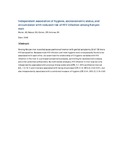Independent association of hygiene, socioeconomic status, and circumcision with reduced risk of HIV infection among Kenyan men
| dc.contributor.author | Meier, AS | |
| dc.contributor.author | Bukusi, EA | |
| dc.contributor.author | Cohen, CR | |
| dc.contributor.author | Holmes, KK | |
| dc.date.accessioned | 2013-06-12T11:37:54Z | |
| dc.date.available | 2013-06-12T11:37:54Z | |
| dc.date.issued | 2006 | |
| dc.identifier.uri | http://erepository.uonbi.ac.ke:8080/xmlui/handle/123456789/32213 | |
| dc.identifier.uri | http://www.ncbi.nlm.nih.gov/pubmed/16885771 | |
| dc.description.abstract | Among Kenyan men recruited as sex partners of women with genital symptoms, 22 of 150 were HIV seropositive. Because male HIV infection and male hygiene were unexpectedly found to be associated with each other, we examined the relationship of 5 hygiene variables with HIV infection in the men in a principal components analysis, controlling for socioeconomic status and other potential confounders. By multivariate analyses, HIV infection in men was not only independently associated with previous illness (odds ratio [OR], 5.1; 95% confidence interval [CI], 1.4-19.1) and inversely associated with being circumcised (OR, 0.12; 95% CI, 0.02-0.91), but also independently associated with a combined measure of hygiene (OR, 0.41; 95% CI, 0.19-0.90 | en |
| dc.language.iso | en | en |
| dc.publisher | University of Washington | en |
| dc.title | Independent association of hygiene, socioeconomic status, and circumcision with reduced risk of HIV infection among Kenyan men | en |
| dc.type | Article | en |
| local.publisher | Department of Laboratory Medicine | en |
Files in this item
This item appears in the following Collection(s)
-
Faculty of Health Sciences (FHS) [10378]

